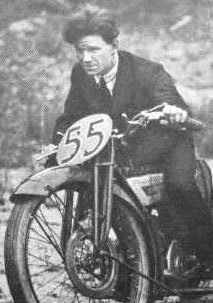Freddie Dixon facts for kids
Frederick William Dixon (1892–1956), known as "Flying Freddie," was an amazing English racer. He was special because he was great at racing motorcycles, cars, and even motorcycles with sidecars! He even designed a cool sidecar system. Freddie won the BRDC Gold Star award twice for his car racing skills.
Contents
Freddie Dixon's Early Life and Racing Start
Freddie Dixon was born in Stockton-on-Tees, England. He left school when he was thirteen. His first job was at a bike shop. Soon after, he started working at a local garage.
In 1909, Freddie got his first motorcycle. Within a year, he was already competing in races! He took part in speed events and hill climbs. His first big race was the Isle of Man TT in 1912. He rode a "Cleveland Precision" motorcycle. However, that machine wasn't quite ready for the tough race.
During World War I, Freddie served in the Royal Army Service Corps for four years. He finished his time in the army as a staff sergeant.
Motorcycle Racing Success
After the war, Freddie started his own business. He opened Park Garage in Middlesbrough. This was also when he really started to shine in motorcycle racing. He earned many top spots in the Isle of Man TT races. These included races in 1921, 1923, 1924, 1926, and 1927.
The Banking Sidecar
Freddie Dixon was especially skilled at motorcycle and sidecar racing. He even designed his own special "banking sidecar" system. This design allowed the sidecar to lean with the motorcycle as it went around corners. It was operated by the passenger using a large lever. The sidecar also had three-wheel disc brakes.
In 1923, Freddie won the Isle of Man TT sidecar race. His passenger was Thomas Walter Denney. They rode a Douglas motorcycle fitted with Freddie's clever banking sidecar.
First to Win Two Types of Races
In 1927, Freddie won another big race. This time, it was the Junior TT on an HRD machine. This made him the first person ever to win both a sidecar race and a solo motorcycle race at the Isle of Man TT! He stopped motorcycle racing in 1928.
Racing Car Achievements
In 1932, Freddie started racing cars. He quickly became famous for his Riley cars. He prepared these cars himself. His achievements in car racing were just as impressive as his motorcycle wins.
- 1934: He won first place in the BRDC 500-mile handicap race at Brooklands. In the same year, he took third place at Le Mans with Cyril Paul. They drove a Riley 12/6 (1.5L) MPH Racing car.
- 1935: He won the BRDC Empire Trophy at Brooklands. He also won the RAC Tourist Trophy race at Ards circuit in Belfast.
- 1936: He won the Brooklands 500-mile race again. He also won the RAC Tourist Trophy at Ards for the second time, with Charles Dodson.
Freddie set a record at Brooklands that was never broken. He was the only person to lap the track at 130 miles per hour in a car with an engine smaller than 2 litres.
Later Work and Legacy
In 1948, the Douglas motorcycle company asked for Freddie's help. They wanted him to improve their T35 motorcycle. This was one of the first new British motorcycle designs after the war. Freddie redesigned the top part of the engine. His changes led to the new Mark 3 Douglas machine.
Freddie Dixon was awarded the British Racing Drivers Club Gold Star twice, in 1934 and 1935. He passed away in 1956 at the age of 64.


